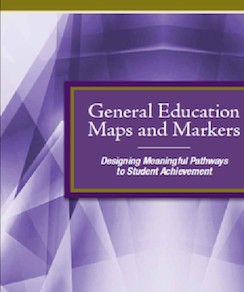At its recent centennial celebration, the Association of American Colleges and Universities (AAC&U) chose to emphasize its commitment to advancing equity in liberal education at both four-year and two-year institutions, a principle that is featured in many of its projects and research endeavors from the last decade. In a space crowded with initiatives designed to improve completion, AAC&U has marked out a unique territory— one that emphasizes equitable student learning within the context of completion. In the words of the AAC&U board, “access to educational excellence is the equity challenge of our time” (see p. 1 of General Education Maps and Markers). After all, what is a completed degree without the learning and skills it is meant to represent?
This equity emphasis has placed the community college sector at the center of AAC&U’s current programming. In fact, AAC&U invited OCCRL’s Dr. Debra Bragg to join one of three national working groups guiding the future and founding principles of one of AAC&Us most ambitious initiatives: General Education Maps and Markers (GEMs). The project set its sights on the radical redesign of general education as a vehicle through which institutions across all sectors, and across all majors, can reach “virtually all degree-seeking students” (see p. 6 of General Education Maps and Markers).
General education takes up some or most of a student’s first two-years of college at any institution; these are also the years in which the largest proportion of students will drop out without completing a degree program. Despite this, there has been very little effort in the field to understand how the general education experience as a whole, not just isolated parts such as development education or student supports, but the entire curricular and co-curricular experience hinders our students and what could be changed to transform outcomes. This focus on a largely untouched issue in higher education change is the most innovative piece of the GEMs project.
The GEMs project debuted two products last month. The first is an introduction and articulated set of principles setting out the GEMs vision for a more integrated, transparent, empowering, and equitable general education program. The GEMs principles aim to turn the foundation of general education—a confusing, “cafeteria style” experience of course selection fraught with transfer barriers, detached and disparate coursework, high-fail rate prerequisites, and a prevailing sense that “these are the classes you just get out of the way”—on its head.

This call resonates with our belief at OCCRL that equity-minded institutional reflection will move us from the idea that “if we had better students, we would have better outcomes,” to the idea that “if we create better processes, our students will demonstrate better outcomes” (see p. 7 of OCCRL’s Process Assessment module). Or in the words of America’s Unmet Promise, it’s time to stop placing “responsibility for student success on the very groups that have experienced marginalization, rather than on the individuals and institutions whose responsibility it is to remedy that marginalization” (see p. 2 of America’s Unmet Promise).
The GEMs vision asks systems and institutions to consider a radical approach to general education reform – a very tall order. The GEMs principles are accompanied by a set of critical questions that might help a committee begin to reflect on the (likely) gaping divide between the GEMs vision and the current institutional reality. However, these tools do not yet outline a systematic approach that would connect principles to critical student outcomes, and finally to sustainable organizational change. The vision is enormous and will require intensive participation from P-20 educators, policymakers, and community stakeholders. Its emphasis on equity will also require a mechanism for analyzing processes or data to identify gaps and validate the equitable impact of solutions aligned to each of the GEMs principles (e.g. student agency, proficiency, integrative learning).
The Pathways to Results initiative at OCCRL has spent years testing and improving a process that can facilitate this kind of equity-driven transformation. PTR provides a structure through which Illinois Community Colleges build partnerships, use disaggregated data, and reflect intentionally on taking institutional responsibility for supporting equitable student outcomes. Given the program’s roots in both the community college and originally in Perkins-funded Career and Technical Education programs, PTR has been applied specifically to individual programs of study and has used input, persistence, and completion metrics to produce evidence of outcomes gaps. To be sure, these data point to significant equity gaps and open a door to reveal faulty processes. However, PTR hasn’t delved as deeply into other sources of data: student voices to reveal experience, agency, and students’ understanding of pathways; student work to reveal inequities in learning; student participation in high-impact practices; long-term career advancement and preparedness to enter four-year universities; and other important markers that the GEMs vision cites as critical to a more equitable future for our students.
Although today GEMs is a vision rather than a process for transformation, we think it is an exciting one, as well as a call to action for OCCRL to think about how PTR, as a tested and equity-minded process, can integrate these important equity components as we strive to transform pathways in Illinois. In the months ahead we plan to work through questions such as:
How can we engage more meaningfully with student voices to create and understand student empowerment and agency? How can we use data to understand students’ experiences in CTE pathways with integrated general education curriculum? How can we reframe “success” and “completion” to include student proficiency (and preparedness for entry into both the workforce and advanced education)? How can PTR be applied to general education learning pathways and transfer processes in Illinois to better understand systemic equity?
We hope those of you who are a part of the OCCRL and PTR networks will start thinking about these challenging questions too. We will continue to explore the possibilities in the next two installments of this blog series on expanding the PTR lens.





Leave a comment